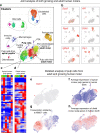Dental cell type atlas reveals stem and differentiated cell types in mouse and human teeth
- PMID: 32968047
- PMCID: PMC7511944
- DOI: 10.1038/s41467-020-18512-7
Dental cell type atlas reveals stem and differentiated cell types in mouse and human teeth
Abstract
Understanding cell types and mechanisms of dental growth is essential for reconstruction and engineering of teeth. Therefore, we investigated cellular composition of growing and non-growing mouse and human teeth. As a result, we report an unappreciated cellular complexity of the continuously-growing mouse incisor, which suggests a coherent model of cell dynamics enabling unarrested growth. This model relies on spatially-restricted stem, progenitor and differentiated populations in the epithelial and mesenchymal compartments underlying the coordinated expansion of two major branches of pulpal cells and diverse epithelial subtypes. Further comparisons of human and mouse teeth yield both parallelisms and differences in tissue heterogeneity and highlight the specifics behind growing and non-growing modes. Despite being similar at a coarse level, mouse and human teeth reveal molecular differences and species-specific cell subtypes suggesting possible evolutionary divergence. Overall, here we provide an atlas of human and mouse teeth with a focus on growth and differentiation.
Conflict of interest statement
P.V.K. serves on the Scientific Advisory Board to Celsius Therapeutics Inc. Other authors declare no competing interests.
Figures










Similar articles
-
New insight into progenitor/stem cells in dental pulp using Col1a1-GFP transgenes.Cells Tissues Organs. 2004;176(1-3):120-33. doi: 10.1159/000075033. Cells Tissues Organs. 2004. PMID: 14745241
-
Endothelin receptors and endothelin-1 in developing rat teeth.Arch Oral Biol. 2007 Jul;52(7):655-62. doi: 10.1016/j.archoralbio.2006.12.022. Epub 2007 Feb 21. Arch Oral Biol. 2007. PMID: 17316550
-
The eternal tooth germ is formed at the apical end of continuously growing teeth.Arch Oral Biol. 2005 Feb;50(2):153-7. doi: 10.1016/j.archoralbio.2004.09.008. Epub 2004 Nov 23. Arch Oral Biol. 2005. PMID: 15721143
-
Growing bioengineered teeth from single cells: potential for dental regenerative medicine.Expert Opin Biol Ther. 2008 Jun;8(6):735-44. doi: 10.1517/14712598.8.6.735. Expert Opin Biol Ther. 2008. PMID: 18476785 Review.
-
On the cutting edge of organ renewal: Identification, regulation, and evolution of incisor stem cells.Genesis. 2014 Feb;52(2):79-92. doi: 10.1002/dvg.22732. Epub 2013 Dec 14. Genesis. 2014. PMID: 24307456 Free PMC article. Review.
Cited by
-
Odontogenic MSC Heterogeneity: Challenges and Opportunities for Regenerative Medicine.Front Physiol. 2022 Apr 19;13:827470. doi: 10.3389/fphys.2022.827470. eCollection 2022. Front Physiol. 2022. PMID: 35514352 Free PMC article. Review.
-
Comparative transcriptome profiles of human dental pulp stem cells from maxillary and mandibular teeth.Sci Rep. 2022 May 25;12(1):8860. doi: 10.1038/s41598-022-12867-1. Sci Rep. 2022. PMID: 35614192 Free PMC article.
-
Dental Pulp Stem Cell Heterogeneity: Finding Superior Quality "Needles" in a Dental Pulpal "Haystack" for Regenerative Medicine-Based Applications.Stem Cells Int. 2022 Jan 4;2022:9127074. doi: 10.1155/2022/9127074. eCollection 2022. Stem Cells Int. 2022. PMID: 35027930 Free PMC article. Review.
-
System-level analyses of keystone genes required for mammalian tooth development.J Exp Zool B Mol Dev Evol. 2021 Jan;336(1):7-17. doi: 10.1002/jez.b.23009. Epub 2020 Oct 31. J Exp Zool B Mol Dev Evol. 2021. PMID: 33128445 Free PMC article.
-
Notum as a Crucial Regulator of Matrix Integrity in Dentinogenesis.J Cell Physiol. 2025 Jul;240(7):e70070. doi: 10.1002/jcp.70070. J Cell Physiol. 2025. PMID: 40685976 Free PMC article.
References
Publication types
MeSH terms
Grants and funding
LinkOut - more resources
Full Text Sources
Medical
Molecular Biology Databases
Research Materials

